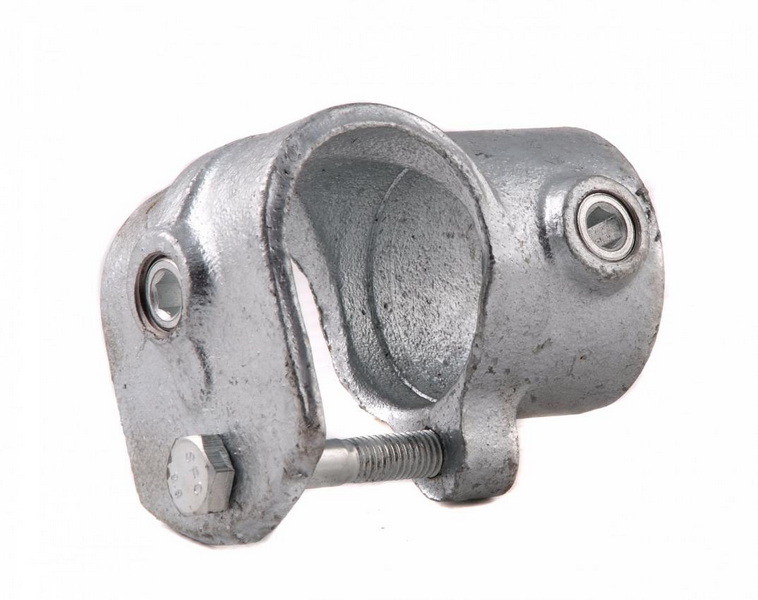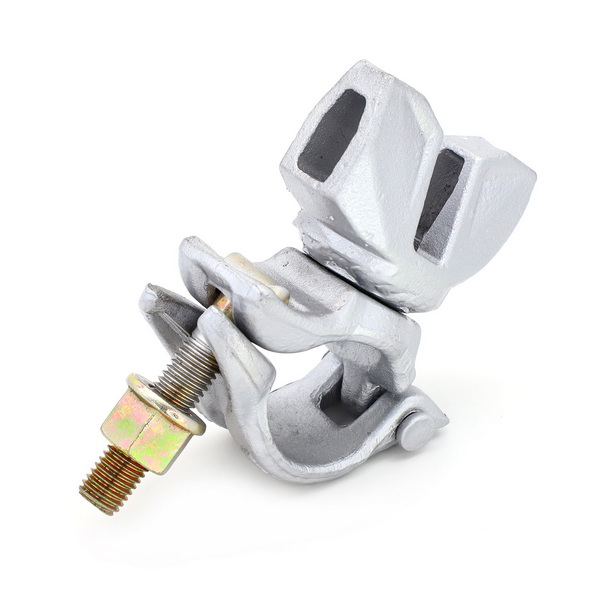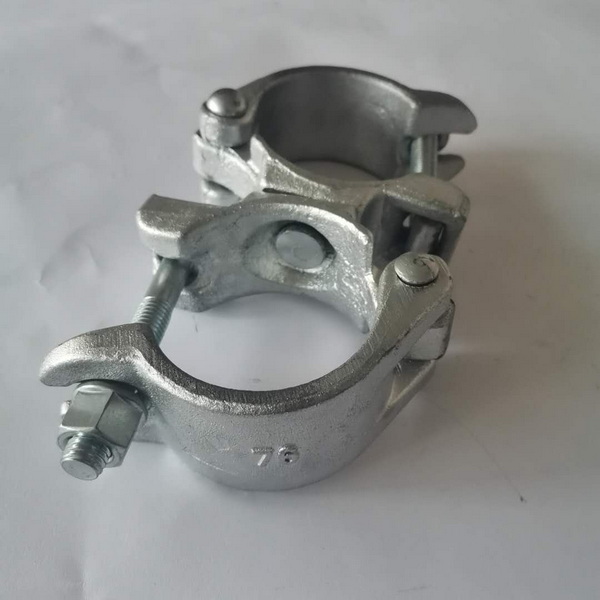Content Menu
● Understanding Scaffold Clamps
● Types of Scaffold Clamps and Their Uses
● Considerations for Mixing Scaffold Clamp Sizes
>> Compatibility
>> Load Capacity
>> Structural Integrity
>> Safety Standards and Regulations
● Best Practices for Using Different Scaffold Clamp Sizes
>> Assess the Requirements
>> Use Compatible Components
>> Distribute Loads Evenly
>> Regular Inspections
>> Consult with Experts
● Potential Risks of Mixing Incompatible Clamps
>> Reduced Load Capacity
>> Instability
>> Safety Hazards
>> Compliance Issues
● Case Studies
>> Case Study 1: Bridge Repair Project
>> Case Study 2: Building Construction Project
● Conclusion
● FAQ
>> 1. Can I use different brands of scaffold clamps together?
>> 2. What is the most important factor to consider when choosing a scaffold clamp?
>> 3. How often should scaffold clamps be inspected?
>> 4. What should I do if I find a damaged scaffold clamp?
>> 5. Are there any specific regulations regarding the use of scaffold clamps?
● Citations:
Scaffolding is a temporary structure used to support workers and materials during construction, maintenance, and repair of buildings, bridges, and other structures. Clamps are critical components of scaffolding systems, providing the necessary connections to ensure stability and safety. One common question that arises is whether different scaffold clamp sizes can be used together. This article explores the considerations, guidelines, and best practices for using various "scaffolding clamp sizes" in conjunction within a scaffolding system, ensuring structural integrity and adherence to safety standards.

Understanding Scaffold Clamps
Scaffold clamps, also known as couplers, are devices used to connect scaffolding tubes together. They come in various sizes and types, each designed for specific purposes. The primary function of these clamps is to provide a secure and rigid connection between scaffold tubes, ensuring that the scaffolding structure can withstand the intended loads. Common types of scaffold clamps include right-angle couplers, swivel couplers, sleeve couplers, and putlog couplers. Each type has a specific load-bearing capacity and is used for different connections within the scaffolding system. A thorough understanding of "scaffolding clamp sizes" and their respective load capacities is essential for safe scaffolding construction.
Types of Scaffold Clamps and Their Uses
1. Right-Angle Couplers: Used to connect two scaffold tubes at a 90-degree angle. These are typically used to join horizontal ledgers to vertical standards.
2. Swivel Couplers: Also known as swivel clamps, these can connect two scaffold tubes at any angle. They are used for diagonal bracing and other non-standard connections.
3. Sleeve Couplers: Used to join two scaffold tubes end-to-end, providing a continuous run. These couplers are essential for extending the length of standards or ledgers.
4. Putlog Couplers: Designed to support putlogs (short horizontal members) that carry the working platform. They connect the putlogs to the ledgers.
Understanding the specific applications and load capacities of these different clamp types is crucial. While varying "scaffolding clamp sizes" might seem convenient, ensuring each clamp is appropriately used is paramount for structural safety.
Considerations for Mixing Scaffold Clamp Sizes
Compatibility
One of the primary considerations when using different scaffold clamp sizes together is compatibility. Ensure that the clamps are designed to work with the specific diameter of the scaffolding tubes being used. Mixing incompatible clamp sizes can result in a loose or insecure connection, compromising the stability of the structure. Most scaffolding systems are designed around standard tube sizes, and clamps are manufactured to match these dimensions. Deviating from these standards can introduce significant risks.
Load Capacity
Different "scaffolding clamp sizes" have different load capacities. It is crucial to ensure that each clamp used in the system is capable of supporting the intended load. Using a smaller clamp in a critical connection point can lead to failure and potential collapse. Always refer to the manufacturer's specifications and relevant safety standards to determine the appropriate load capacity for each clamp. Properly distributing loads and using clamps with adequate capacity are essential for maintaining the structural integrity of the scaffolding.
Structural Integrity
Maintaining the structural integrity of the scaffolding is paramount. Mixing different clamp sizes can create weak points in the structure if not done correctly. Ensure that the connections are rigid and secure, and that the overall system is capable of withstanding the expected loads and environmental conditions. Consult with a qualified engineer or scaffolding expert to assess the structural implications of using different clamp sizes together.
Safety Standards and Regulations
Adherence to safety standards and regulations is non-negotiable in scaffolding. Many countries and regions have specific regulations regarding the use of scaffolding clamps, including requirements for load capacity, compatibility, and inspection. Ensure that all clamps used in the system meet these requirements, and that the scaffolding is erected in accordance with the relevant safety guidelines. Ignoring these standards can result in fines, project delays, and, most importantly, serious accidents.

Best Practices for Using Different Scaffold Clamp Sizes
Assess the Requirements
Before erecting the scaffolding, conduct a thorough assessment of the project requirements. Determine the loads that the scaffolding will need to support, the dimensions of the structure, and any specific challenges or constraints. This assessment will help you determine the appropriate types and sizes of clamps needed for the project.
Use Compatible Components
Whenever possible, use clamps and tubes that are specifically designed to work together. This ensures compatibility and maximizes the strength and stability of the connections. Avoid mixing components from different manufacturers unless you have verified that they are compatible and meet the required safety standards.
Distribute Loads Evenly
Ensure that loads are evenly distributed throughout the scaffolding structure. Avoid concentrating heavy loads on a single connection point, as this can overload the clamp and lead to failure. Use additional supports or bracing to distribute the load more effectively.
Regular Inspections
Conduct regular inspections of the scaffolding to identify any signs of wear, damage, or loose connections. Pay particular attention to the clamps, as these are often the weakest points in the system. Replace any damaged or worn clamps immediately. Regular inspections are essential for maintaining the safety and stability of the scaffolding.
Consult with Experts
If you are unsure about any aspect of the scaffolding design or erection, consult with a qualified engineer or scaffolding expert. These professionals can provide valuable guidance and ensure that the scaffolding is safe and compliant with all relevant regulations. Seeking expert advice can help prevent costly mistakes and potentially life-threatening accidents.
Potential Risks of Mixing Incompatible Clamps
Reduced Load Capacity
Using incompatible clamps can significantly reduce the load capacity of the scaffolding. This can create a dangerous situation, as the structure may not be able to support the intended loads.
Instability
Mixing different "scaffolding clamp sizes" can lead to instability in the scaffolding structure. Loose or insecure connections can cause the scaffolding to sway or collapse, especially under heavy loads or in windy conditions.
Safety Hazards
The use of incompatible clamps can create numerous safety hazards for workers on the scaffolding. These hazards include the risk of falls, collapses, and injuries from falling debris.
Compliance Issues
Using incompatible clamps can result in non-compliance with safety standards and regulations. This can lead to fines, project delays, and legal liabilities.
Case Studies
Case Study 1: Bridge Repair Project
In a bridge repair project, a contractor used a mix of different "scaffolding clamp sizes" to erect a temporary work platform. During a routine inspection, it was discovered that some of the clamps were not compatible with the scaffolding tubes, resulting in loose connections. The contractor was forced to dismantle the scaffolding and replace the incompatible clamps, resulting in significant project delays and additional costs.
Case Study 2: Building Construction Project
In a building construction project, a worker used a smaller clamp to connect a ledger to a standard, unaware of the reduced load capacity. The scaffolding collapsed under the weight of the workers and materials, resulting in serious injuries. An investigation revealed that the use of the incorrect clamp size was a contributing factor to the collapse.
These case studies highlight the importance of using compatible and appropriately sized clamps in scaffolding systems.
Conclusion
While it may be possible to use different "scaffolding clamp sizes" together in certain situations, it is essential to carefully consider the compatibility, load capacity, structural integrity, and safety standards. Adhering to best practices, conducting regular inspections, and consulting with experts can help minimize the risks and ensure the safety of the scaffolding system. Ultimately, prioritizing safety and compliance is crucial for protecting workers and preventing accidents on the construction site.

FAQ
1. Can I use different brands of scaffold clamps together?
It is generally not recommended to mix different brands of scaffold clamps unless you have verified that they are compatible and meet the required safety standards.
2. What is the most important factor to consider when choosing a scaffold clamp?
The most important factor to consider when choosing a scaffold clamp is its load capacity. Ensure that the clamp is capable of supporting the intended load on the scaffolding structure.
3. How often should scaffold clamps be inspected?
Scaffold clamps should be inspected regularly, ideally before each use, to identify any signs of wear, damage, or loose connections.
4. What should I do if I find a damaged scaffold clamp?
If you find a damaged scaffold clamp, you should replace it immediately with a new, undamaged clamp.
5. Are there any specific regulations regarding the use of scaffold clamps?
Yes, many countries and regions have specific regulations regarding the use of scaffold clamps, including requirements for load capacity, compatibility, and inspection. Ensure that you are familiar with and comply with these regulations.
Citations:
[1] https://www.tp-scaffold.com/can-different-scaffold-clamp-sizes-be-used-together.html
[2] https://brandsafway.com/uploads/files/orn401_bsl_tube_and_clamp_product_brochure.pdf
[3] https://www.iwenma.com/Download/Tube%20and%20Fittings%20Scaffold%20User%20Manual_Wenma.pdf
[4] https://www.wm-scaffold.com/scaffolding-coupler.html
[5] https://www.acrow.com.au/wp-content/uploads/2020/11/couplers-product-guide.pdf
[6] https://www.cuiclamps.com/scaffold-clamps.html
[7] https://www.keyclampsonline.co.uk/collections/48-3mm-key-clamps
[8] https://www.scaffoldingsupplies.co.uk/products/scaffold-fittings.html






















